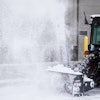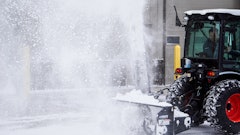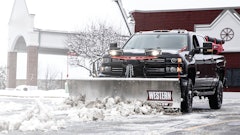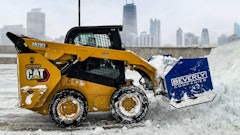
By the time a snowstorm comes roaring onto the radar, snow and ice removal companies have already begun to run out of time to prepare for what’s to come.
That’s why it’s important that they streamline operations to become as efficient as possible during the busy winter months.
“Time is of the essence with snow, and you have to be able to adapt to the conditions at the drop of a hat,” says Elizabeth Bonadonna, president of Busy Beaver Lawn & Garden, in West Seneca, N.Y. “You need a plan to make sure people are safe from the conditions but also that you are providing services you promised. Streamlining operations, reducing waste and increasing efficiency can all affect the bottom line of your business.”
Bonadonna and Joe Uran, president of Nordic Snow Management in Hopkins, Minn., discussed how they keep their snow operations running smoothly and effectively.
Busy Beaver Lawn & Garden
For Busy Beaver Lawn & Garden, the recipe for a seamless snow season comes down to making the right hires, thorough training and implementing technology to streamline processes and communication.
“We believe in hiring the right management team and teaching them the secret recipe for success, empowering our staff to make the right decisions, coaching them on how to adapt and overcome and providing feedback and reflecting on what worked and what didn't,” Bonadonna says.
Hiring and retention
At the beginning of a snow season, Busy Beaver holds a “winter kickoff,”—part in-class training and part hands-on demonstrations.
The class reviews standards and expectations, and the hands-on portion includes familiarizing staff with equipment and reiterating safety features and functions.
“We have site maps and route lists that are all digitized, like a Service Autopilot application that has all the information they’d need, and then we also make sure they know how to operate the equipment properly—things like putting on a box and taking it off, what our standards are and what the industry standards are,” Bonadonna says.
The company, which staffs about 50 to 70 employees based on the snow event, also takes employees on site visits to show them what needs to be done and where to put the snow.
“We show them where the equipment’s staged, how to grease the equipment, make sure they know how to start it and ensure that they know specific details about it,” Bonadonna says. “We provide patterns for them, but we also try to empower people to utilize their skill sets as best they can because they know what works. They know the wind patterns and what’s most efficient.”
The company has been providing such training since its inception.
“We believe it makes operations smooth and provides structure for our staff and our customers,” Bonadonna says.
To bring the hires in the front door in the first place, Busy Beaver relies on a hiring software and word of mouth.
“The software is constantly bringing in candidates, but it’s also our marketing and word of mouth,” Bonadonna says. “When people work with us and they like our company, they’re going to tell their friends that this is a great company with a great work culture. People see that we have structure and a good culture, and that’s attractive.”
Systems and processes
During the offseason, Busy Beaver’s staff is busy creating programs and a winter game plan using technology such as SiteMaps.
“This way, it’s all prepared with our contractual obligations and specifics to know hours, shift changes and maps,” Bonadonna says.
Additionally, the company’s equipment is all staged and ready when the winter season begins, thanks, in part, to its own fleet of mechanics it keeps staffed to service equipment.
“We have several hubs, but people will know where they’re dispatched to and what the expectations for service are at each site,” Bonadonna says.
During wintertime, the company implements checkoff sheets to know what sites were serviced and guarantee that processes were fully functioning. It also ensures that dispatch and office support are available 24/7 during snow events.
“It’s taking the time to know that you have X amount of time, X amount of equipment, X amount of people, and that you can use all of that efficiently,” Bonadonna says. “Taking all these things into consideration shows that the leadership continually wants to improve and rise above the rest. We believe teams realize when an organization is putting their best foot forward and making it better today for tomorrow.”
Nordic Snow Management
Communication through technology, preseason prep and ready-to-roll equipment are three big factors keeping Nordic Snow Management’s operations up and running.
“With snow, you basically have one chance and a 12-hour window to get it done,” Uran says. “You can’t call and say that you didn’t get there for this reason or the other, so we spend a lot of time preseason making sure everything is well planned and that there are backup plans. When problems do arise, we can take care of them quickly and still have everything completed.”
Equipment focus
For each site that it plows, Nordic Snow Management, which focuses purely on commercial sites, dedicates specific pieces of equipment to that site.
“We match equipment to the site because you wouldn’t use a pickup truck to plow a big box store the same way you wouldn’t use a large wheel loader to plow a driveway at a house,” Uran says. “A big thing for us is equipment purchasing and planning and then matching that equipment to specific sites.”
At its current capacity, all of the equipment Nordic owns is committed to sites. As the company adds new contracts, it seeks out new equipment specific to those routes or sites.
“So, if we were to pick up a shopping center, we would evaluate the contract length and value and potentially go purchase something for that site,” Uran says.
More so than helping with efficiency, Uran says, this strategy helps with money.
“Equipment is typically more money upfront, but it’s cheaper to own and operate in the snow industry,” Uran says. “We started using the stuff we already own and put it to work. Then, as we grow, we purchase and seek out equipment specific to our needs for the upcoming season.”
To ensure its equipment is in tiptop shape, the company performs pre- and postseason inspections on all vehicles and performs maintenance and big repairs in the spring.
“Fall is very busy, so by then, everything is ready to go,” Uran says. “You never know when the snow will start, so by the preseason inspections, it’s quick once-overs to make sure nothing has changed and sending the machines out.”
Communication and technology
Communicating with staff is another key to efficient operations, Uran says.
Before every snow event, the company communicates expectations and whether any changes are expected.
“Once we get started, we’re in constant communication with everybody to see how things are going, and we monitor in real time with GPS, so if we start to notice a crew or area is behind, we have flex positions or management people that will help that crew catch up.”
Similarly, if a crew is behind or there are equipment issues, Nordic will be flexible and pull equipment from a different route to use on the route that crews are struggling to keep clear.
While the tracking is done through GPS and the snow management system, Yeti, communication and dispatching calls are made via phone.
“With Yeti, it’s already prebuilt, so crews only need to log in, and the info they need for each site is already there,” Uran says. “There are site maps, site notes and other site information that anybody can go in and understand what we’re trying to accomplish. It lists where the snow goes and what to watch out for, complete with pictures and maps.”
Finally, Uran notes that it’s crucial to have a backup plan.
“Don’t overcommit yourself. That’s a common problem,” Uran says. “Undercommit your equipment and people because when a big storm comes and a problem arises, you’re stuck if you’re constantly scheduling at 100 percent capacity and there’s no room to adjust.”




![Doosan Bobcat Wacker Neuson Stack 2ec Js Pb V6e[1]](https://img.greenindustrypros.com/mindful/acbm/workspaces/default/uploads/2025/12/doosan-bobcat-wacker-neuson-stack2ecjspbv6e1.CPyyz8ubHn.png?auto=format%2Ccompress&bg=fff&fill-color=fff&fit=fill&h=100&q=70&w=100)







![Doosan Bobcat Wacker Neuson Stack 2ec Js Pb V6e[1]](https://img.greenindustrypros.com/mindful/acbm/workspaces/default/uploads/2025/12/doosan-bobcat-wacker-neuson-stack2ecjspbv6e1.CPyyz8ubHn.png?ar=16%3A9&auto=format%2Ccompress&bg=fff&fill-color=fff&fit=fill&h=135&q=70&w=240)

![Gravely Pro Turn Mach One My23 Dsc03139 Edit 1200x800 5b2df79[1]](https://img.greenindustrypros.com/mindful/acbm/workspaces/default/uploads/2025/10/gravely-pro-turn-mach-one-my23-dsc03139-edit-1200x800-5b2df791.BucBnDoN22.jpg?ar=16%3A9&auto=format%2Ccompress&fit=crop&h=135&q=70&w=240)


![Kubota Snow ah3 Sgv25ua[1]](https://img.greenindustrypros.com/mindful/acbm/workspaces/default/uploads/2025/10/kubota-snowah3sgv25ua1.bAUoUSziui.png?ar=16%3A9&auto=format%2Ccompress&bg=fff&fill-color=fff&fit=fill&h=135&q=70&w=240)


